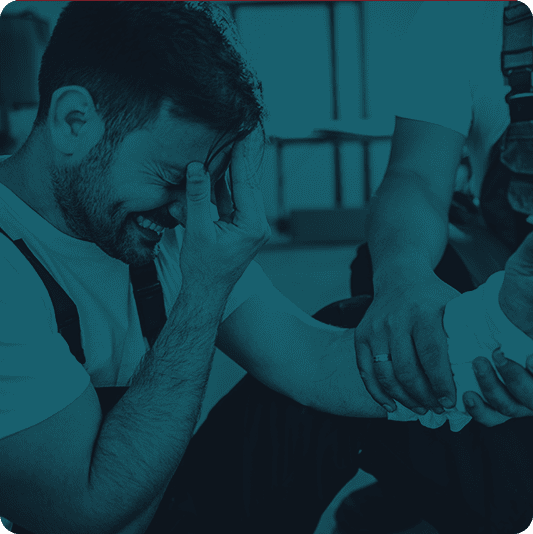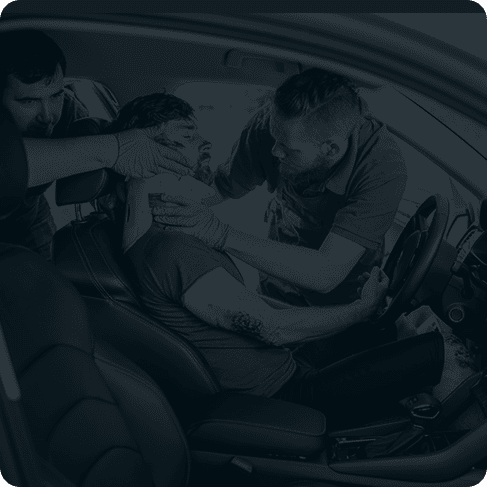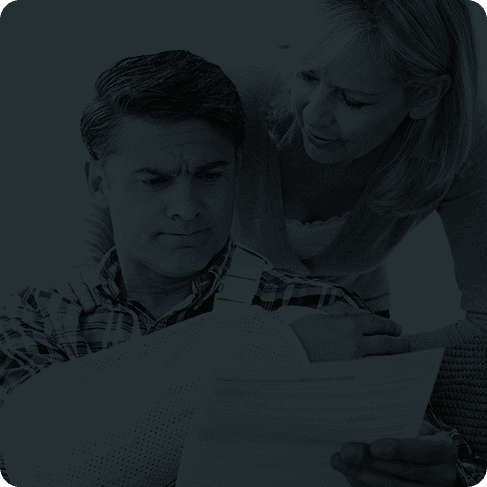We work hard from the very first moment because that gets our clients the best results. -Nicole Denmon, Founding Partner
When someone invites you into their home or onto their land, the owner has a legal responsibility to keep you safe from dangerous conditions.
Likewise, when you go to a department store, grocery store, or other business you expect a safe environment.
You relied on that promise of a reasonably safe environment when you went shopping in that big chain store. After all, the store invited you in so it could sell you merchandise and make a profit.
You were shopping like you had done so many times before. You were pushing your shopping cart. You were not scanning the floor in front of your cart to look for dangerous spots — because you were looking at the products on display that the store so carefully puts out and assumed you were safe.
It happened so fast. Your legs went out from under you, and you went crashing down onto the hard floor.
You knew instantly something was wrong with your body. The pain shot out immediately. You didn’t even have time to brace your body for the impact from falling onto the cold floor.
You could not understand how the floor could give way so quickly! But then you look over to where you were standing and see a slippery substance on the floor. Why was that there?
And sure, you’re in pain. But what if a child was running down the aisle and had slipped on that substance?
You slowly got up but knew you needed to get to the emergency room. The pain was already shooting down your legs. Did you break a bone or tear something in your leg?
You go to the emergency room and it’s clear — you’ve injured yourself. You’re going to need medical treatment to get you fixed. You’re clearly going to miss some work.
It’s not that you want to sue anyone. After all, you’ve heard stories of sue-happy people who are filing frivolous lawsuits. That’s not you.
But you’re hurt. It’s going to be expensive to get you back to where you were before this accident.
Who’s going to pay your medical bills? And are you entitled to some sort of reasonable compensation for all that’s happened to you?
You wonder, “do I have a case?”
Below is a guide for slip and fall cases that we put together. You can use this guide to help you gain a preliminary understanding of if you have a case, how a slip and fall attorney proves your case, how your bills get paid, and what the value of your slip and fall injury case might be.
Proving A Slip And Fall Case
At its heart, proving a slip and fall case requires showing there was a dangerous condition on a property, the owner or his/her employees knew about that condition and didn’t act reasonably to protect you.
SHOWING THAT A DANGEROUS CONDITION EXISTED
The first step in proving a slip and fall case is showing there was a dangerous condition on the premises.
If you were injured after you slipped and fell in a grocery store, what caused you to fall? If you fell because there was a dangerous scenario, then the first element of negligence would be met.
For example, consider a wet, slippery substance left on the floor in a Publix.
Or consider the large box improperly placed on the top shelf at a Walmart, which is teetering on the edge of that shelf and could fall down in a moment’s notice.
In these scenarios, the company that you’re expecting to provide a safe environment has left dangerous conditions in the store.
And now you’re injured as a direct result of these dangerous conditions.
However, slip and fall cases happen in other places besides your big chain stores.
Other examples of dangerous conditions that could lead to slip and fall injuries include:
If you’ve been invited to go somewhere or have a reasonable expectation that it’s safe to be somewhere, the person who owns that property has a duty to ensure there aren’t any dangerous conditions that can hurt you or other visitors.
And if you are injured because someone violated that duty, then you have the first element of a slip and fall claim.
FAILURE OF A LANDOWNER TO REASONABLY PROTECT YOU
However, just having a dangerous condition on the premises is not enough to establish a slip and fall claim.
After all, stores and other places of commerce are businesses. There’s a lot of people coming and going.
Mistakes happen.
Sometimes water is spilled, sometimes floors break, and sometimes shelves collapse.
And while it would be absolutely unfortunate if you are hurt as a result of a mistake by the store, it would not necessarily justify a slip and fall claim.
Your injury has to be more than just a freak accident.
What matters is, how does the store owner respond to these conditions?
Or more importantly, did the owner or his/her employees act in a reasonable way to protect you from the dangerous condition?
For example, sometimes there’s water on the floor. A reasonable person would put a big sign up to let you know that’s a dangerous place and to avoid it.
The business owner would also have policies and procedures in place to ensure store employees keep a lookout for dangerous conditions and fix them right away.
If the business reasonably tries to correct the situation, then the business is doing everything that we can expect under the circumstances.
In such cases, there may not be a viable slip and fall claim even if you were hurt — because the business was doing the best it could.
That’s because for a business to be liable for damages, the business has to act negligently. A property owner or his/her employees have to violate the duty to act reasonably to protect you.
But what if there’s an unreasonable delay in the time it took for the business to ask someone to clean up a dangerous condition?
What is the dangerous condition was not an accident at all, but was the result of employees acting sloppy and not following the standard operating procedures that are in place to protect you? And as such, the dangerous condition was caused by the business’ management not doing their job to ensure the property is a safe place?
In the above scenarios, business owners are not acting reasonably to protect their visitors.
And if a business owner is not acting reasonably to protect his/her guests, and a guest gets hurt because of a dangerous condition, that’s a slip and fall case where you have a claim.
WHEN A SLIP AND FALL ATTORNEY ANALYZES A CASE, HE OR SHE LOOKS FOR:
A slip and fall case always comes down to whether the business did the right thing.
Was the company sloppy because it worried about its profits first at the expense of its customers?
Or did the company put good safeguards in place to protect its guests?
When a person gets injured because of a dangerous condition in a store or another place, that person doesn’t have time to think about recording evidence or figuring out what caused the accident to happen. If you’re injured, you’re probably only concerned about the pain and getting to a hospital or an urgent care clinic to start the healing process.
While that’s completely understandable, it can make it hard to create a valid slip and fall claim. Under the law, the burden to prove there was a dangerous condition and the landowner acted unreasonably is placed onto the slip and fall attorney.
And as you can imagine, it doesn’t take long for records to disappear, videos to go missing, and employees to get their stories together; it is easy for them to make it where the version of recorded facts don’t show any fault on the company’s part.
That means of all personal injury practice areas, slip and fall cases generally require the most proactive and lightning-quick responses from slip and fall attorneys.
Damages And Slip And Fall Cases
Of course, slip and fall claims require something besides a dangerous condition and negligent behavior on the part of a landowner or business owner.
You must have suffered some sort of damage as a result of the other party’s negligent behavior.
Sometimes people slip and fall, but they quickly get up and dust themselves off because they were not injured.
In situations where there’s no injury and therefore no damages suffered, there isn’t going to be much of a case.
However, more often than not slips and falls cause injuries; they cause damages to people like you.
Damages in slip and fall cases include both economic damages and non-economic damages.
Economic damages are things to which we can assign a specific dollar amount. For example, medical bills are economic damages. If you needed to go to the hospital and then have follow-up treatment or even surgery to get yourself back to normal, then you’ve had economic damages. Such economic damages will be the total amount of medical bills you must pay out-of-pocket. If you have health insurance, then the portion you pay is considered economic damages.
Lost wages are another form of economic damages. If the injuries you suffered cause you to be unable to work, then we can calculate how much money you’ve lost because of your slip and fall. Again, we can assign a dollar amount to the economic damages of your lost wages.
Non-economic damages are fuzzier, but no less important or serious than economic damages.
These include the pain that you felt because of the injuries, embarrassment, mental anguish, post-traumatic stress disorder (PTSD), and other sorts of intangible damages.
These are harder to quantify with a dollar value. After all, what is the pain you deal with every day worth in dollars and cents?
So while these are real — and in many cases the value of pain and suffering can exceed the dollar amount assigned to economic damages — they can be more difficult to articulate to the insurance company in order to determine a finite value.
Loss of consortium is another type of non-economic damage. This is when your injuries make you unable to be the father, mother, husband, or wife you once were. Loss of consortium claims can be raised by your family members because you cannot do the things you once could.
How Much Is A Slip And Fall Case Worth?
Slip and fall cases can lead to substantial compensation. However, values vary widely depending on the facts of each case. Unlike a motor vehicle accident, where liability is often clear cut and the real issue is the dollar amount awarded for damages, slip and fall cases are usually more difficult to prove from the liability perspective.
There are a few reasons for this.
First of all, it can be somewhat difficult to find out if the store knew about the dangerous condition. In other words, the store will often take the position that they were acting reasonably and they simply didn’t know that the dangerous condition existed — or it only existed for a few minutes before the accident.
Slip and fall cases are often against big stores like Walmart and Publix. These stores take very aggressive stances in defending cases. It’s not uncommon, even in good cases, for these big stores to give a zero offer in the pre-suit process and only resolve the case after exhaustive litigation.
That’s okay. But it is another complicating factor when it comes to determining what an individual slip and fall case is worth.
Slip and fall cases are also heavily dependent on you, the plaintiff. Have you had other slip and fall accidents before? Have you had injuries before from auto accidents or the like? Will you be likable at deposition and in front of a jury? We and the companies we sue for slip and fall cases all consider the answers to these questions.
Finally, what are the damages? Did a medical provider treat you right after the accident? Can we find medical experts to help us prove these injuries are related to this accident rather than a pre-existing condition or another accident?
In our practice, we’ve found that the best course of action is to go full on in the investigation and preparation of a slip and fall case from the very beginning. This includes gathering evidence from the store, getting court orders to prevent the store from destroying evidence, making sure our clients have been seen by doctors who truly know what their injuries are and what treatment will be required to get better, and collecting our clients’ past medical history.
By doing this early on, we help our clients better understand the value of their cases sooner rather than later and also secure larger settlements and larger verdicts on the cases that do go to trial.
Our Expertise
We have your back. Whatever you might be suffering from, accidents, injuries or medical malpractice, we have you covered throughout Florida
Let’s get in touch!
The initial consultation is absolutely FREE
Denmon Pearlman
Law
Tampa Office
2504 W Crest Ave
Tampa, FL 33614
(813) 554-3232
Denmon Pearlman
Law
St. Petersburg Office
520 2nd Ave South
St. Petersburg, FL 33701
(727) 493-5610
Denmon Pearlman
Law
New Port Richey Office
5703 Main Street
New Port Richey, FL 34652
(727) 753-0049
Denmon Pearlman
Law
Brooksville Office
1790 E Jefferson St.
Brooksville, FL 34601
(352) 309-7354
Denmon Pearlman
Law
Seminole Office
5290 Seminole Blvd. Suite D
St. Petersburg, FL 33708




